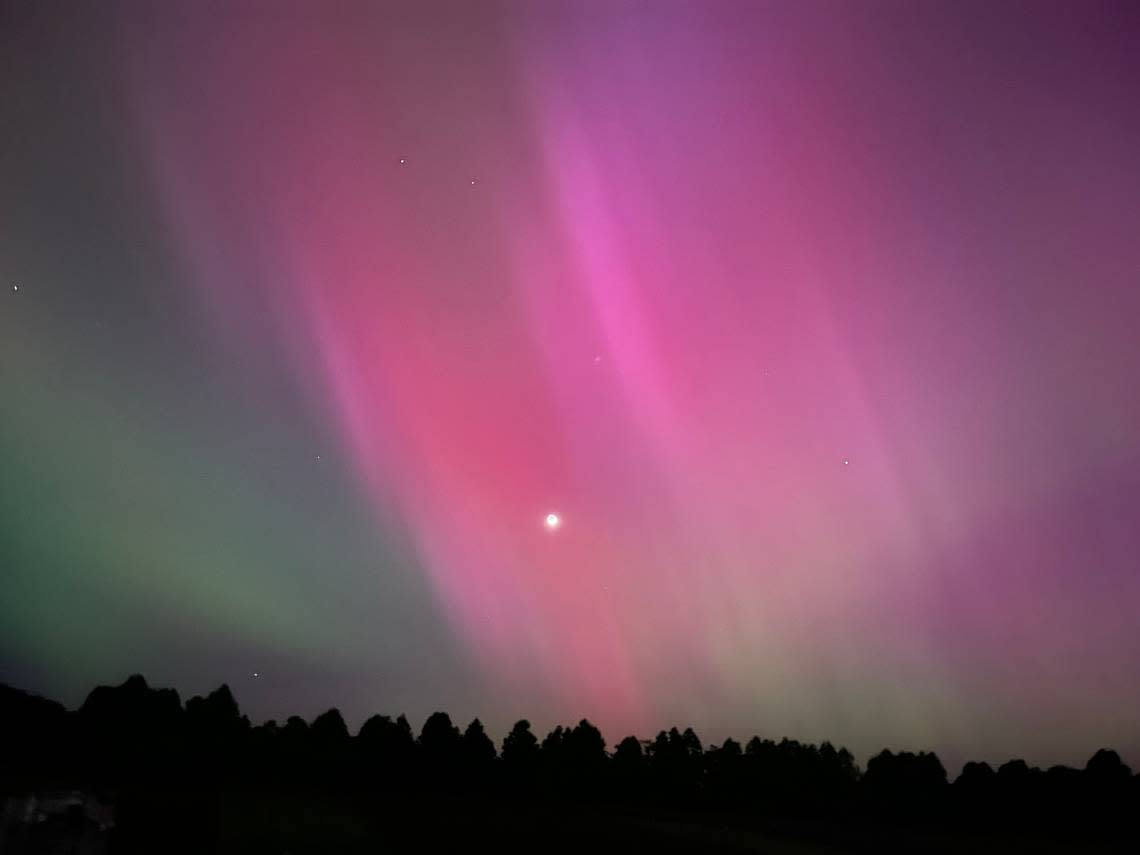Want to catch a glimpse of the Northern Lights in Kentucky this weekend? Here’s how.

Kentuckians from one end of the state to the other checked off what for many was a bucket list item Friday night, as the Northern Lights lit up the sky with color.
For those who missed the show, there may be a second chance to see the aurora borealis Saturday night or Sunday night, according to the National Oceanic and Atmospheric Administration’s Space Weather Prediction Center.
Philomon Geertson, a meteorologist for the National Weather Service in Jackson, said those who want to catch a glimpse of the aurora will have the best chances if they get as far from city lights and other artificial light sources as possible.
He said it’s also helpful to have an open view to the north, and those who live in valleys would want to try to seek a spot with higher elevations.
“The higher you are and the more open your view is, the better,” Geertson said Saturday afternoon.
While skies were somewhat overcast at times Saturday, Geertson said the clouds would clear out across most of the area to give a good view of the sky by nightfall.
Some social media users mentioned that it was easier to see the lights while viewing them through their phone cameras. While they said they could see little with the naked eye, some said the photos they took showed more brilliant colors.
Solar flares and coronal mass ejections, or CMEs, from a region of active spots on the sun are causing what the Space Weather Prediction Center says are very rare “Severe-Extreme” geomagnetic storms.
These storms are causing the aurora borealis to show up much farther south than is typical, and the center said “there have been reports of power grid irregularities and degradation to high-frequency communications and GPS.”
The center said Saturday that “another series of CMEs associated with flare activity ... are expected to merge and arrive at Earth by midday” Sunday, making more periods of geomagnetic storms likely.
Because of that, the center said the aurora borealis might be visible “over much of the northern half of the country and maybe as far south as Alabama.”
The best times for possible viewing are between 10 p.m. and 2 a.m., WKYT Meteorologist Jim Caldwell said in a Facebook post Saturday.
Geertson said Friday night’s lights were most visible from around 9 p.m. to midnight.
“The threat of additional strong flares and CMEs will remain until the large and magnetically strong sunspot cluster ... rotates out of view over the next several days,” the Space Weather Prediction Center said Saturday.
Another series of CMEs associated with flare activity from Region 3664 over the past several days are expected to merge and arrive at Earth by midday (UTC) on 12 May. Periods of G4-G5 (Severe-Extreme) geomagnetic storms are likely to follow the arrival of these CMEs. pic.twitter.com/353Iopnhly
— NOAA Space Weather Prediction Center (@NWSSWPC) May 11, 2024
The extreme geomagnetic storm continues and will persist through at least Sunday... pic.twitter.com/GMDKikl7mA
— NOAA Space Weather Prediction Center (@NWSSWPC) May 11, 2024
Sunspot Region 3664 remains active and continues to produce X-class flares... pic.twitter.com/yhE4vbS7FN
— NOAA Space Weather Prediction Center (@NWSSWPC) May 11, 2024
The last time there was a geomagnetic storm of this magnitude was in October 2003, Geertson said.
Social media was awash in colorful images people captured during the light show Friday night.
The Northern Lights over I-75 in Lexington, Kentucky. pic.twitter.com/qLa2ZukzZY
— Jack Weaver (@jack_weaver_) May 11, 2024
Never in a million years would I have thought I could see northern lights in my own Kentucky backyard. pic.twitter.com/ONNpn29aDZ
— SketchbookKatie (@SketchbookKatie) May 11, 2024
Northern lights in Mt. Sterling @Kentuckyweather #awesome pic.twitter.com/TKqX1j8toz
— Alan Shepherd (@ashep2) May 11, 2024
Mackville! Amazing pic.twitter.com/hVSgGK1EX7
— Jessica Cecilia (@lucycatcharlie) May 11, 2024
async
Northern Madison County, KY@Kentuckyweather @ryanhallyall #aurora pic.twitter.com/AKy4mRaycu
— Matthew H (@matt_h_297) May 11, 2024
src="https://platform.twitter.com/widgets.js"
Northern lights in western Morgan County @Kentuckyweather pic.twitter.com/oCiNEqJus4
— Braden Gullett (@braden_gullett) May 11, 2024
charset="utf-8">
Amazing! Kentucky #kywx #aurora @Kentuckyweather pic.twitter.com/Pinpzq0Ytw
— Jason (@jaythebull99) May 11, 2024

